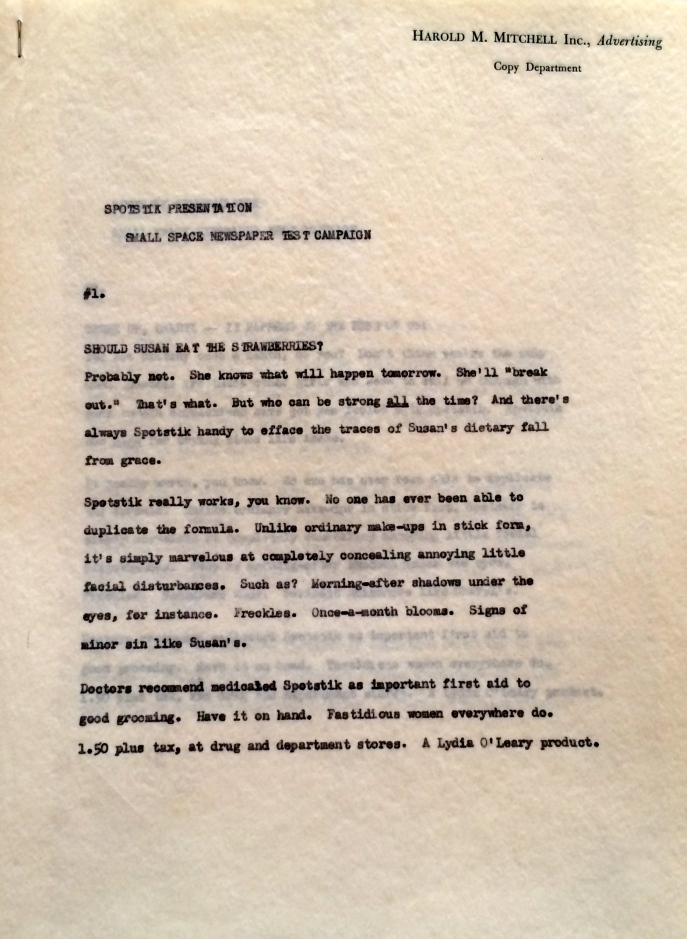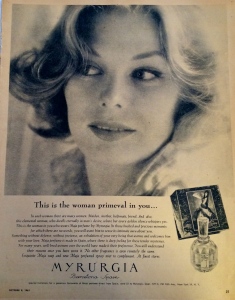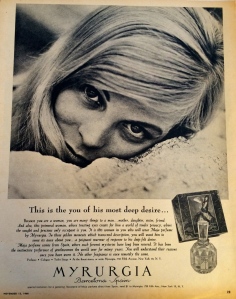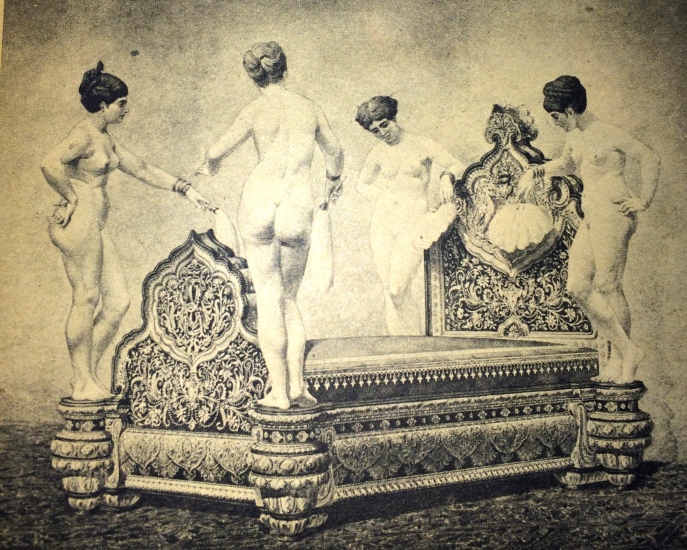Getting paid as a copywriter by Harold M. Mitchell, of Harold M. Mitchell, Inc., was, metaphorically, a walk in the park. As the weather in the spring of 1960 improved, it was sometimes a real walk in the park as well — Bryant Park behind the main New York library on Fifth Avenue being a pleasant lunchtime destination. Harold did not watch the clock, and there was never a whole lot for me to do.
In fact, it was hard to say Harold was in the ad business at all, at least as I had come to know it, although he was certainly in some kind of ad business, running advertisements of another kind entirely. Moreover, the business he had must have been profitable enough to fund his spacious operation on the third floor of a Fifth Avenue building between 39th and 40th Streets, convenient for forays to Lord & Taylor across Fifth when the weather prevented midday excursions to the park.
In fact, Harold had a whole roster of clients. They were drugstores, discount stores such as Klein’s, and auto supply stores, for which he bought space in newspapers and flyer inserts, then placed the weekly (and sometimes twice-weekly) all-print ads of twelve to twenty-four specials per page which alerted client customers to come hurrying in for mega savings. For this he did not need a copywriter, as the clients provided the bare-bones copy themselves. (I never had anything to do with any client he already had.) But he did need an unambitious art director and a humble paste-up person. These two sat alone with lots of space around them in a cavernous, decently lit studio behind the two front offices. There they bored themselves into somnolence fiddling with the innumerable full-page “Save! Save! Save!” ads that put bread with butter on it on all our tables.
Neeedless to say, Harold had greater ambitions. He wanted to place ads for prestige products (or at least products sold full price in department stores) in glossy magazines (or at least the Times Sunday Magazine section) — so that Harold M. Mitchell, Inc. could at last become a real Madison Avenue advertising agency. As far as I could see within a week of joining his enterprise to assist him, he had three strikes against him in realizing this goal:
(1) His art director, a charmingly exhausted-looking dark-haired fellow from France in his early forties whose name I’ve forgotten so let’s call him Jean-Pierre, lacked all awareness of the currently favored look of print ads at the Art Directors’ Association of New York. Moreover, during our long conversations when there was nothing to do (which was often), and after he had decided he could trust me, Jean-Pierre indicated he had life plans which did not include a career with Harold. These plans were temporarily on hold because they depended on the agreement of another. This “other,” who would frequently emerge from the elevator around five o’clock to be taken out for a drink before dinner, was a Chinese youth who looked to be no more than twenty, spoke neither French nor English well enough for me to understand him, and always wore a sulky expression which did not bode well for “agreement.” I suspected that for him Jean-Pierre was a deep-pocket meal ticket and that both of them were therefore going to be in for a big surprise.
That’s because Jean-Pierre had also shared with me his modus operandi when personal outgo exceeded personal income. You could delay payment of bills without injury to your credit rating by writing a check for what you owed Store 1, putting it in an envelope addressed to Store 2, and vice versa. That bought you a month’s grace at each store. Of course, this was in the days before computers, when real people in real accounts-receivable departments opened real envelopes, looked at what was in them and called you up if you had made a “mistake.” Alas for the Chinese youth if his meal ticket was juggling stores and checks like that. I foresaw heartbreak for Jean-Pierre and hours of mutual commiseration ahead if we were both still “working” for Harold that long.
(2) Harold had no portfolio of glossy ads to show potential clients of the sort he coveted. All he had, now that he had me, was my portfolio of ads — unfortunately designed by the art director at The Gilbert Agency and not by Jean-Pierre. But he also had the gift of gab. He certainly did talk our way through several brand-name company doors. And he was a cock-eyed optimist. He could make advertising sound like the answer to any poor profit picture you could describe. Since he had to bring me along on these exploratory visits in order to display my portfolio, I needed better clothes.
Ed, my unemployed husband, thought the place for me to shop (if absolutely necessary) was in the Sears Roebuck catalogue, preferably for garments made of reprocessed wool because they were cheaper. I was therefore still wearing, in rotation, three suits bought at J.W. Robinson in Los Angeles, on my mother’s employee discount, to teach college English five years before. (To some things — like reprocessed wool — I simply could not stoop.) Without remorse, I had thus begun keeping from Ed my father’s birthday and Christmas checks, allegedly meant for both us. I cashed them at the bank where we had our joint savings account and kept the proceeds at the bottom of my purse, from which the money could easily have been stolen, but wasn’t.
Since there was lots of leisure at Harold M. Mitchell, Inc. to check out the sales at Lord and Taylor, Peck & Peck and the boutiques a block away on Madison Avenue, I was able to seize the day if the price tag was right. Once I had smuggled a bargain home and squirreled it away in my closet, I was safe from inquiry. Ed never noticed — new, old — what I put on. My prize acquisition during this period was a black cashmere knitted dress from Italy. European designer imports were still very new. The dress had been $150 at The Cashmere Shop but had dropped to $20 by April. So there to reprocessed wool!
(3) Harold had abiding faith in the power of the written word. The triumph of the visual in early 1960’s advertising had completely passed him by, just as it had Jean-Pierre. Harold loved it that I had been an English major with an A.B.D. (all but dissertation). He loved it that I had written drama criticism in Los Angeles for a monthly magazine called Frontier and wanted me to bring in whatever copies I had kept so he could read my columns. He even asked if he could read my master’s thesis on Edmund Wilson, the literary critic. I dissuaded him from including these accomplishments of mine among his talking points to, say, the manufacturers of Spotstik, the coverup for facial blemishes, whose offices we visited at some point that spring. But he did insist on my drafting pages of speculative copy for every presentation we made. Secretly I believed pages of test campaign copy were the wrong approach, but who was I to argue? Besides, they were fun to do.
I never learned the outcome of what I thought of as Harold’s doomed efforts at Spotstik since — spoiler alert! — I had moved on by the end of June. But it’s barely possible that he actually did manage to prevail over company doubts and persuade someone somewhere at the company to try a small space test campaign. If so, it would have had a tiny photograph of a Spotstik accompanying the following:
#1. SHOULD SUSAN EAT THE STRAWBERRIES? Probably not. She knows what will happen tomorrow. She’ll “break out.” That’s what. But who can be strong all the time? And there’s always Spotstik handy to efface the traces of Susan’s dietary fall from grace.
Spotstik really works, you know. No one has ever been able to duplicate the formula. Unlike ordinary make-ups in stick form, it’s simply marvelous at completely concealing annoying little facial disturbances. Such as? Morning-after shadows under the eyes, for instance. Freckles. Once-a-month blooms. Signs of minor sin like Susan’s.
Doctors recommend medicated Spotstik as important first aid to good grooming. Have it on hand. Fastidious women everywhere do. 1.50 plus tax, at drug and department stores. A Lydia O’Leary product.
There were more, many more. To wit: “Cheer up, Cheryl — It Happens to the Best of Us!” and “Sheila Should Have Danced All Night!” and “What Will Debby Do When They Pass the Chocolate Candy?” Plus nine others. But I will spare you (unless someone really b-e-g-s to read them all.) Let us hurry right along to my major accomplishment during the time I spent with Harold.
The Myrurgia Presentation. Myrurgia was a Spanish perfume company then new to America and seeking to wedge itself onto upscale department store counters next to Chanel No 5, Arpege, Joy, Madame Rochas and the like. Somehow Harold had made his way, alone, into its New York office, was invited to make a presentation and brought back a bottle of Maja by Myrurgia to inspire me. The company was talking maybe full-page ads in the Sunday Times: Harold’s dream come true.
We opened the bottle and each inhaled deeply. “What do you think?” he asked, after recovering from the overpowering aroma emanating from the bottle. Personally, I thought Maja by Myrurgia smelled the way a brothel might smell, had I ever visited a brothel, which of course I hadn’t, but could imagine. I was unable to divulge this opinion to Harold. He was such a nice appreciative man, and had saved me from near-destitution and having to spend too much time in the company of my husband.
“Mm, earthy?” I suggested.
“I’m sure you can come up with something,” Harold said, hurrying away to his own office, which had a window one could open. He had such confidence in me.
I was twenty-nine, my marriage was a train-wreck and I was getting through as much of my life as I could with the help of daydreams, mostly of an erotic nature. Over the next two days, I wrote three pieces of Myrurgia copy slowly, by hand, savoring every word — with the explicit instruction at the top of each page when I finally typed them up that the illustration should be of a beautiful, tastefully naked woman in a seductive, reclining position, front or back view being up to Jean-Pierre. Did I get somewhat carried away?
The first:
This is the woman primeval in you…
In each woman there are many women. Maiden mother, helpmate, friend. And also, this elemental woman, who dwells eternally in man’s desire, where her every golden silence whispers yes. This is the woman in you who wears Maja perfume by Myrurgia. In those hushed and precious moments for which there are no words, you will want him to sense its intimate aura about you. Something without defense, without pretense, an exhalation of your very being that warms and welcomes him with your love. Maja perfume is made in Spain, where there is deep feeling for these tender mysteries. For many years, well-bred women over the world have made it their preference. You will understand their reasons once you have worn it. No other fragrance is even remotely the same… At finest stores.
The second:
The you that only he will ever know…
Each woman to the world plays many parts…friendly, helpful, charming, kind. But only in the shelter of a deep, abiding love does she reveal the trusting, most essential she by which man knows that she is ‘Woman.’ At such an hour as this you will wear Maja perfume by Myrurgia. In those unguarded moments when you become the only woman in the world, you will want it to whisper assent to his desire…an unspoken message in the silent language of the heart. Maja perfume comes from Spain, where these tender mysteries have long been understood. It has been the preference of cosmopolitan women the world over for half a century. Once you have worn it, you will know why. No other fragrance is even remotely the same.
A-n-d:
This is the you of his most deep desire…
Because you are a woman, you are many things to a man…mother, daughter, sister, friend. And also, this primeval woman, whose trusting eyes create for him a world of tender privacy, where the sought and precious only occupant is you. It is this woman in you who will wear Maja perfume by Myrurgia. In those golden moments which transcend description, you will want him to sense its aura about you…a poignant murmur of response to his deep-felt desire. Maja perfume comes from Spain, where such fervent mysteries have long been revered. It has been the instinctive preference of gentlewomen the world over for many years. You will understand their reasons once you have worn it. No other fragrance is even remotely the same.
It was certainly a fact that no other fragrance was even remotely the same. But the only real mystery is how Harold ever sold this fervently heavy-breathing kerfuffle to a company hoping to make it in New York with well-bred cosmopolitan gentlewomen (to use the language of the ads). This stuff actually ran in the Sunday Times, not only the following fall, but also the year after. It’s true Jean-Pierre had toned down my specified visuals. No more naked Maja. Instead we saw three well-bred-looking fully dressed models as far from my hot-blooded “woman primeval” as you could imagine. It must have been his Parisian aesthetic.
Nevertheless, I tore each of these disappointing pages out of the Times to save for my portfolio in the event there was a cataclysmic revolution in tastes in advertising during my lifetime — although by the time they appeared, an employment agent at Jerry Fields had already made good on her promise that something would come along for me.
But before we move on to this next chapter in my ad biz adventures, you may ask what ever became of Myrurgia after its god-awful entry into American merchandising as designed by Jean-Pierre and me. I’m pretty sure Saks and Bergdorf’s never made room for it on their perfume counters. But believe it or not, it’s still around today. Perfume.com offers the eau-de-toilette for 19.95. This is part of what you can read about it there:
Create an alluring, tempting vibe wherever you go while you’re wearing this Maja fragrance for women. Released in 1921…this timeless and captivating scent by Myrurgia has been wowing the masses for the better part of a century. It…lingers behind, even after you’ve left the room.”
Whether “wowing the masses” is a better inducement to purchase than “woman primeval” I leave to your discriminating judgment. In the meanwhile, I shall pass on to the story of my first six months at an agency with a real Madison Avenue address. It was there I finally achieved a legal separation from Ed in my private life while professionally having to deal with a client proud of having made this:
That should keep you hanging till next time.






Wonderful post, but I wouldn’t belittle one of the products you wrote ad copy for! Lydia O’Leary’s Spotstik was an indispensable weapon in my zitz-zapping arsenal! In fact, I wish I had some today (for age spots). I also remember Maja–the ads in particular! It was a cheap, tarty scent–in the same league as Evening in Paris, which you could buy at the Five-and-Ten.
LikeLike
Did I belittle Spotstik? It was the ad presentation I was posting about, not the merits of the product. As for Maja, doesn’t “smell like a brothel” equate with “cheap, tarty?” So we’re really on the same page after all!
LikeLike
I only know Maja soap which I used to buy for my mother for…wait for it…Mother’s day! It did smell lovely. I like how you smuggled your final legal separation from Ed in at the last paragraph. Keeping us all in suspension. With snitzing his half of Daddy’s checks and your erotic daydreaming I am not surprised.
You’re an interesting woman NINA.
LikeLike
(1) Gerard, since I thought Maja smelled like a brothel, I cannot agree that it also smelled “lovely.” However, I will not argue. To each his own.
(2) If my father had known — and he didn’t, because I was ashamed to tell him — that his only daughter’s husband was lying around the house doing essentially nothing while expecting her to support him, pay his monthly child support obligations, shop for him, cook for him, clean for him, do his laundry, earn him free theater tickets, take care of his four children on vacation, wear reprocessed wool, and be general playmate on weekends, I can assure you he would not have called her cashing his gift checks and keeping all the money for herself “snitzing.” Perhaps things are different in Australia.
(3) Thank you for your thoughtful observation.
LikeLike
(1) Fair crack of the whip Nina.
(2) “Without remorse, I had thus begun keeping from Ed my father’s birthday and Christmas checks, allegedly meant for both us. I cashed them at the bank.”
(3) Ok;” keeping from”, “taking”, “without remorse”.
(4) Snitzing= Poetic license in Australia.
LikeLike
Sorry, I don’t get your (2), (3) and (4), and therefore cannot reply. I appreciate your interest in the blog.
LikeLike
I’m loving your Mad Memoirs but I can’t help but feel sad for the disillusionment that grew in you as you grappled with an unsatisfying career and a disappointing husband. Beautifully, poignantly written, as always.
LikeLiked by 1 person
Thank you, Julie, as always, for your appreciation. You shouldn’t feel sad, though. I never thought of advertising as my “career”; it was simply a paycheck. And yes, the marriage was a bad mistake from the start. So from one point of view, you could say I threw my twenties away. But how many young people are truly happy? And look at the rich lode of writing material that decade of my life produced! The marriage itself, on which I’m touching only very lightly in this account, deserves a memoir (perhaps fictionalized) — with many more of the truly awful things that were in it — all to itself.
LikeLiked by 1 person
This is becoming compulsive reading. But what a cliff-hanger – I can’t wait to hear more about that bed…..
LikeLiked by 1 person
Patience, patience… (she said, smiling).
LikeLiked by 1 person
Cashmere dress for $20! There were some high spots.
LikeLiked by 1 person
There are always high spots. Although let’s put the $20 in perspective. It wasn’t today’s $20. The $150 the dress had cost before Christmas was likely the equivalent of $500 or $600 today. So the $20 I paid had the purchasing power of perhaps $65 or $70 today. But I loved that dress for many years. And even back then, in the days of my penury, I believed in buying less but the best you could afford.
LikeLiked by 1 person
A laugh a minute. What a history you have. I keep reading the copy then having to adjust my spectacles as the well-bred-gentlewoman wafts onto the stage.
The bed is operatic… I can’t wait.
LikeLiked by 1 person
Oh my gosh, I love this. The ad copy is great, and it was actually exciting to see the real live ads! But my favorite thing was that you squirreled away those checks!
LikeLiked by 1 person